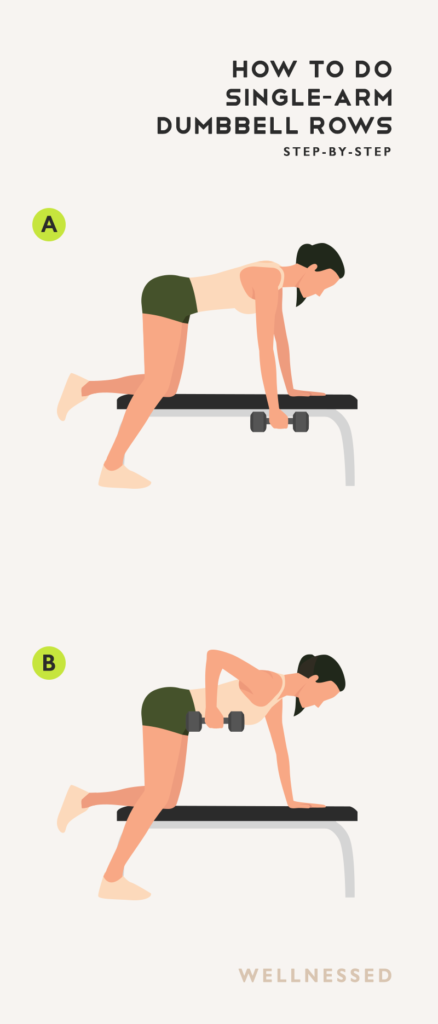- Main muscles worked: Back (latissmus dorsi, teres major and minor, trapezius, rhomboids) and back of shoulders (posterior deltoids)
- Other muscles: Upper arm (biceps)
- Exercise type: Unilateral, horizontal pull
- Equipment: Dumbbell, bench
Benefits of One-Arm Dumbbell Rows
This exercise is a more beginner-friendly variation of bent-over rows. One-arm dumbbell rows allow you to focus closely on one arm at a time and puts less strain on your back, because your free arm provides additional stability and balance to help keep your spine in good alignment. This makes single-arm dumbbell rows a good stepping stone to the full bent-over row.
Furthermore, because you are working each arm separately you are able to address left-to-right strength imbalances, ensuring both arms are equally strong.
Avoid using weights that are too heavy. It leads to poor form and you are likely to end up using momentum to lift the dumbbell.
Who should not do one-arm rows? Single-arm dumbbell rows put less strain on the back than bent-over rows. Nevertheless, if you suffer with shoulder or back problems you should still be careful and seek the advice of a qualified health professional before commencing this exercise to avoid exacerbating or causing injury.
Form
Tips & Common Mistakes
The main issue with one-arm dumbbell rows is making sure you work the right body part. It’s all too easy to turn it into an arm exercise targeting the biceps, instead of working the muscles of the back. Getting this move right is all about the detail.
Back & Torso
- Do not round your upper back or overarch your lower back. Your upper body should be roughly parallel to the floor, with your lower back naturally arched throughout of the movement and your head in line with your spine.
- Initiate the movement with your back, not by pulling with your arms. Although you are moving your arms, this is a back exercise. Actively focus on lifting the dumbbell with muscles of your back, rather than with your arms – you should feel the tension in your back. To help with his, think about leading with your elbow, driving the dumbbell back towards your ribs, and squeezing your shoulder blade towards your spine.
- Do not twist your torso up as you lift the weight, only your arm should move. Your torso should be about parallel to the ground throughout the movement. Equally, keep your shoulders level as you lower the dumbbell back to starting position. It’s a common mistake to lower the dumbbell too far down, causing the shoulder to drop.
Elbows
- Keep your elbow tucked in to your sides. Your forearm should remain roughly vertical throughout the movement. Avoid flaring your elbow when you lift the dumbbell, as this puts the shoulder in an awkward position.
Weight
- Lift the weight up and back, towards your ribs. Avoid the mistake of pulling it only up, towards your shoulders.
- Do not lower the weight inward under the body or forwards under the head. Lower the dumbbell back to the starting position, which is your arm fully extended directly under your shoulder.
- Raise and lower the dumbbell with control. Avoid using momentum, do not jerk dumbbell up or drop the dumbbell down.



